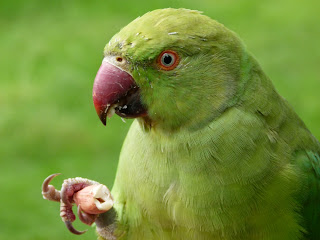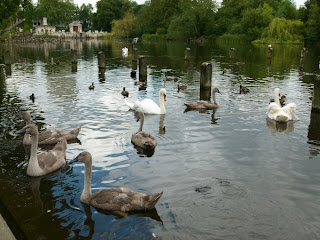Saturday, 21 July 2012
The Ring-Necked Parakeets have returned from their summer holiday in the fields, and are as keen as ever for peanuts. Unlike other birds, they seem to prefer peanuts to the more expensive kinds. Perhaps they find shelling them amusing.
The Mute Swans from the Lido came to the shore next to the Peter Pan statue to be fed. The lone male swan who lives on the Long Water, who lost his mate and his nest, probably to a fox, resented this intrusion. Here he is approaching in the background, and the male of the pair, on the right with wings half raised in threat, is heading out to confront him.
They had a long bout of circling each other threatingly, but did not come to blows. Meanwhile, a Grey Heron thought it would fun to buzz them.
Eventually the dispute was settled. The Lido swans now rule the territory on the right side of the line of posts, and the lone swan has the territory on the left. But any crossing of the line will bring trouble.
I saw two Reed Warblers at the patch of reeds on the Long Water next to the bridge. One flew down from a tree and vanished into the reeds, and then I heard faint calls in what sounded like a Reed Warbler's scratchy voice from the tree. It could have been a young Great Tit calling for food; I was not sure. So I looked up into the branches, and got a momentary but clear glimpse of a Reed Warbler moving around in the twigs, I suppose looking for insects.
A pair of Coots has built a nest inside the outflow of the Serpentine. There is a large filter bed behind the balustrade, under the path. I heard young Coots calling plaintively from inside, while a pair of adults stood on the weir, over which water was flowing briskly.
I hope the young birds can get out. In previous years a Coots' nest here has failed, and a Moorhen's nest has succeeded; but young Moorhens are more agile than Coots and better able to jump up the weir.
Roy Sanderson has looked at the picture of the ring on the leg of a Black-Headed Gull that I put on the blog on the 18th. He has changed his mind about it, and think it may be one of his. He writes:
'It is a British ring. The "NW" is actually part of www , the web site address of the BTO [British Trust for Ornithology]. In quite small letters above that is part of "museum", the address to send the ring number to. The ring number is possibly EX 6369x, the x being a missing number; EX is a guess. That series of ten EX numbers was used by me in December 2011, all in Hyde Park. 63693 was seen in Bushy Park and 63694 in Regent's Park before they left for their breeding sites, probably in the Netherlands or Scandinavia.'
It shows how much information you can get from a ring, even when it's a guess at a partial number.
Subscribe to:
Post Comments (Atom)




Congratulations on actually SEEING two Reed Warblers. I am envious. I thought I had done well, being serenaded by the one at the end of the Serpentine whilst I drank my apple juice. I am so glad that you did catch the Heron in the circling Swan photo. Beautiful Parakeet study. Your close-ups are so much better than mine. I have been practicing on my potted plants but must make time to go back and Read the Instructions sometime.
ReplyDelete